engine FIAT DUCATO BASE CAMPER 2015 Owner handbook (in English)
[x] Cancel search | Manufacturer: FIAT, Model Year: 2015, Model line: DUCATO BASE CAMPER, Model: FIAT DUCATO BASE CAMPER 2015Pages: 367, PDF Size: 19.73 MB
Page 63 of 367
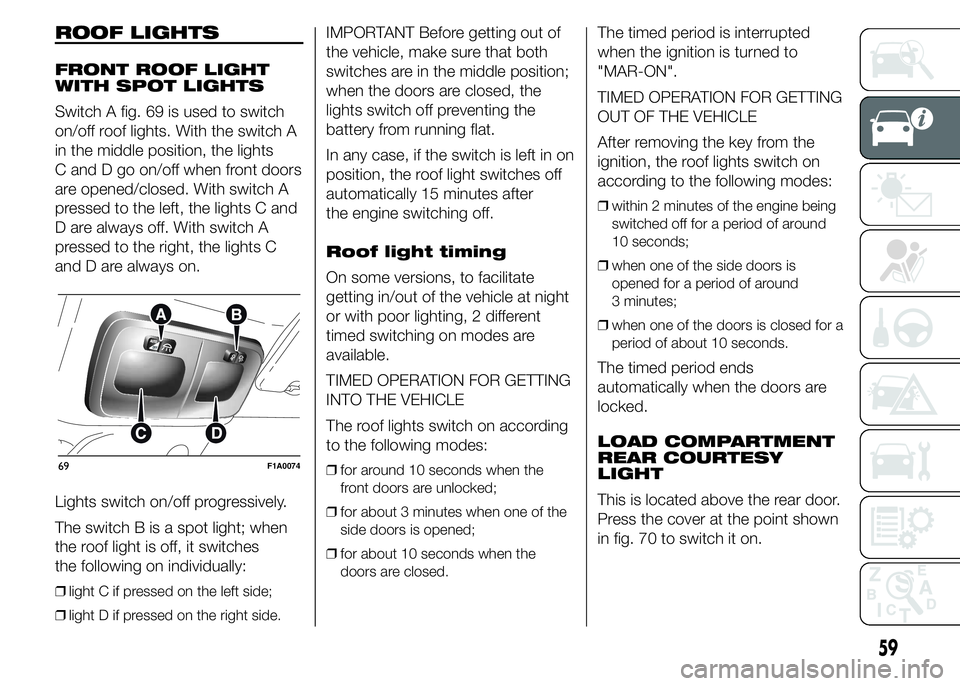
ROOF LIGHTS
FRONT ROOF LIGHT
WITH SPOT LIGHTS
Switch A fig. 69 is used to switch
on/off roof lights. With the switch A
in the middle position, the lights
C and D go on/off when front doors
are opened/closed. With switch A
pressed to the left, the lights C and
D are always off. With switch A
pressed to the right, the lights C
and D are always on.
Lights switch on/off progressively.
The switch B is a spot light; when
the roof light is off, it switches
the following on individually:
❒light C if pressed on the left side;
❒light D if pressed on the right side.
IMPORTANT Before getting out of
the vehicle, make sure that both
switches are in the middle position;
when the doors are closed, the
lights switch off preventing the
battery from running flat.
In any case, if the switch is left in on
position, the roof light switches off
automatically 15 minutes after
the engine switching off.
Roof light timing
On some versions, to facilitate
getting in/out of the vehicle at night
or with poor lighting, 2 different
timed switching on modes are
available.
TIMED OPERATION FOR GETTING
INTO THE VEHICLE
The roof lights switch on according
to the following modes:
❒for around 10 seconds when the
front doors are unlocked;
❒for about 3 minutes when one of the
side doors is opened;
❒for about 10 seconds when the
doors are closed.
The timed period is interrupted
when the ignition is turned to
"MAR-ON".
TIMED OPERATION FOR GETTING
OUT OF THE VEHICLE
After removing the key from the
ignition, the roof lights switch on
according to the following modes:
❒within 2 minutes of the engine being
switched off for a period of around
10 seconds;
❒when one of the side doors is
opened for a period of around
3 minutes;
❒when one of the doors is closed for a
period of about 10 seconds.
The timed period ends
automatically when the doors are
locked.
LOAD COMPARTMENT
REAR COURTESY
LIGHT
This is located above the rear door.
Press the cover at the point shown
in fig. 70 to switch it on.
69F1A0074
59
Page 67 of 367
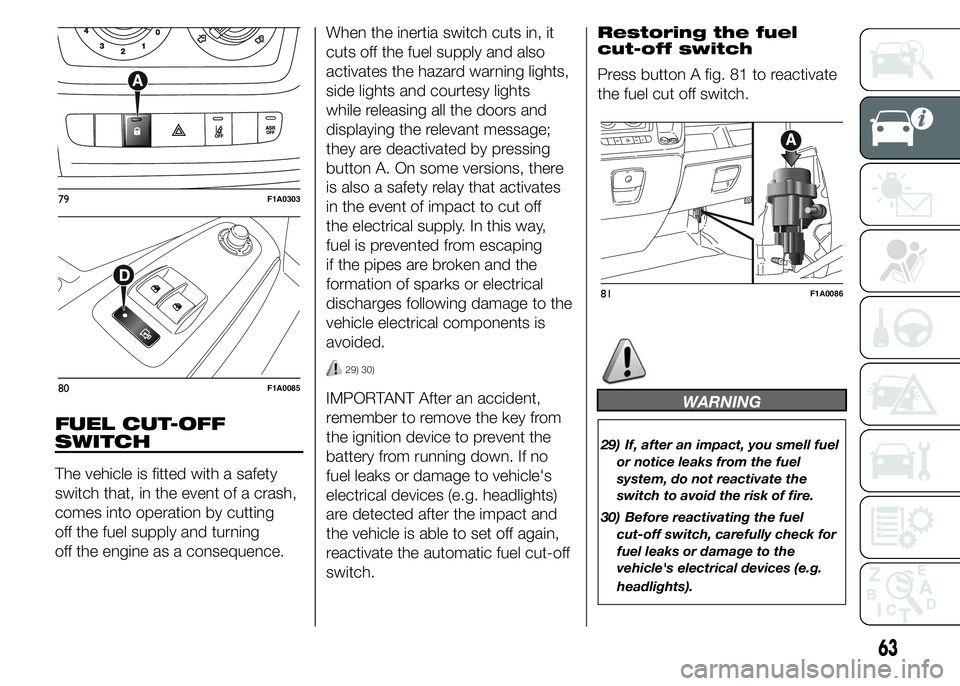
FUEL CUT-OFF
SWITCH
The vehicle is fitted with a safety
switch that, in the event of a crash,
comes into operation by cutting
off the fuel supply and turning
off the engine as a consequence.When the inertia switch cuts in, it
cuts off the fuel supply and also
activates the hazard warning lights,
side lights and courtesy lights
while releasing all the doors and
displaying the relevant message;
they are deactivated by pressing
button A. On some versions, there
is also a safety relay that activates
in the event of impact to cut off
the electrical supply. In this way,
fuel is prevented from escaping
if the pipes are broken and the
formation of sparks or electrical
discharges following damage to the
vehicle electrical components is
avoided.
29) 30)
IMPORTANT After an accident,
remember to remove the key from
the ignition device to prevent the
battery from running down. If no
fuel leaks or damage to vehicle's
electrical devices (e.g. headlights)
are detected after the impact and
the vehicle is able to set off again,
reactivate the automatic fuel cut-off
switch.Restoring the fuel
cut-off switch
Press button A fig. 81 to reactivate
the fuel cut off switch.WARNING
29) If, after an impact, you smell fuel
or notice leaks from the fuel
system, do not reactivate the
switch to avoid the risk of fire.
30) Before reactivating the fuel
cut-off switch, carefully check for
fuel leaks or damage to the
vehicle's electrical devices (e.g.
headlights).
79F1A0303
80F1A0085
81F1A0086
63
Page 75 of 367
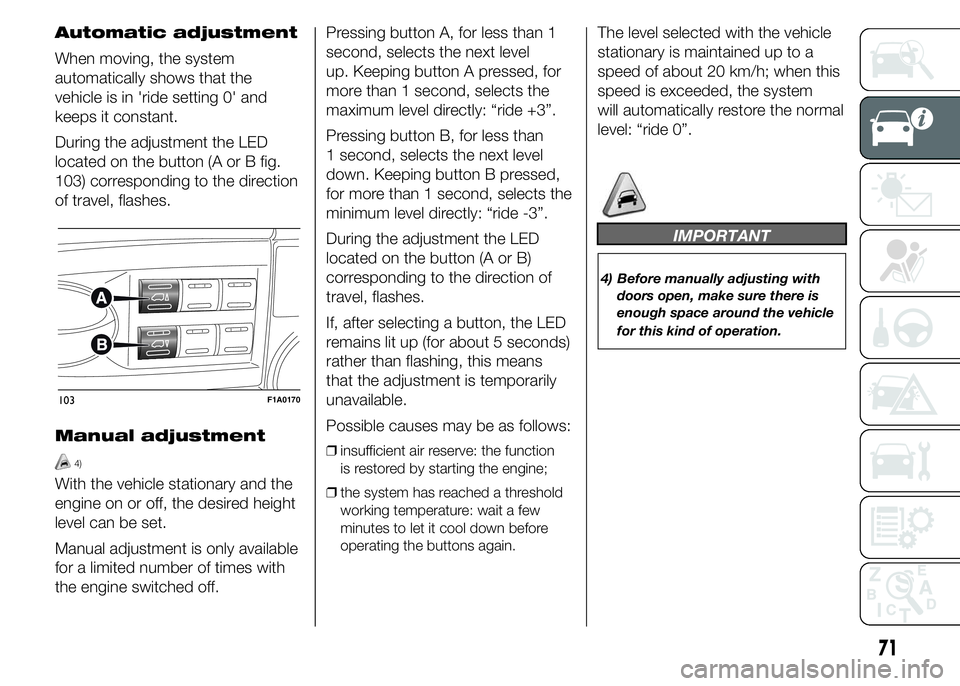
Automatic adjustment
When moving, the system
automatically shows that the
vehicle is in 'ride setting 0' and
keeps it constant.
During the adjustment the LED
located on the button (A or B fig.
103) corresponding to the direction
of travel, flashes.
Manual adjustment
4)
With the vehicle stationary and the
engine on or off, the desired height
level can be set.
Manual adjustment is only available
for a limited number of times with
the engine switched off.Pressing button A, for less than 1
second, selects the next level
up. Keeping button A pressed, for
more than 1 second, selects the
maximum level directly: “ride +3”.
Pressing button B, for less than
1 second, selects the next level
down. Keeping button B pressed,
for more than 1 second, selects the
minimum level directly: “ride -3”.
During the adjustment the LED
located on the button (A or B)
corresponding to the direction of
travel, flashes.
If, after selecting a button, the LED
remains lit up (for about 5 seconds)
rather than flashing, this means
that the adjustment is temporarily
unavailable.
Possible causes may be as follows:
❒insufficient air reserve: the function
is restored by starting the engine;
❒the system has reached a threshold
working temperature: wait a few
minutes to let it cool down before
operating the buttons again.
The level selected with the vehicle
stationary is maintained up to a
speed of about 20 km/h; when this
speed is exceeded, the system
will automatically restore the normal
level: “ride 0”.
IMPORTANT
4) Before manually adjusting with
doors open, make sure there is
enough space around the vehicle
for this kind of operation.
103F1A0170
71
Page 83 of 367
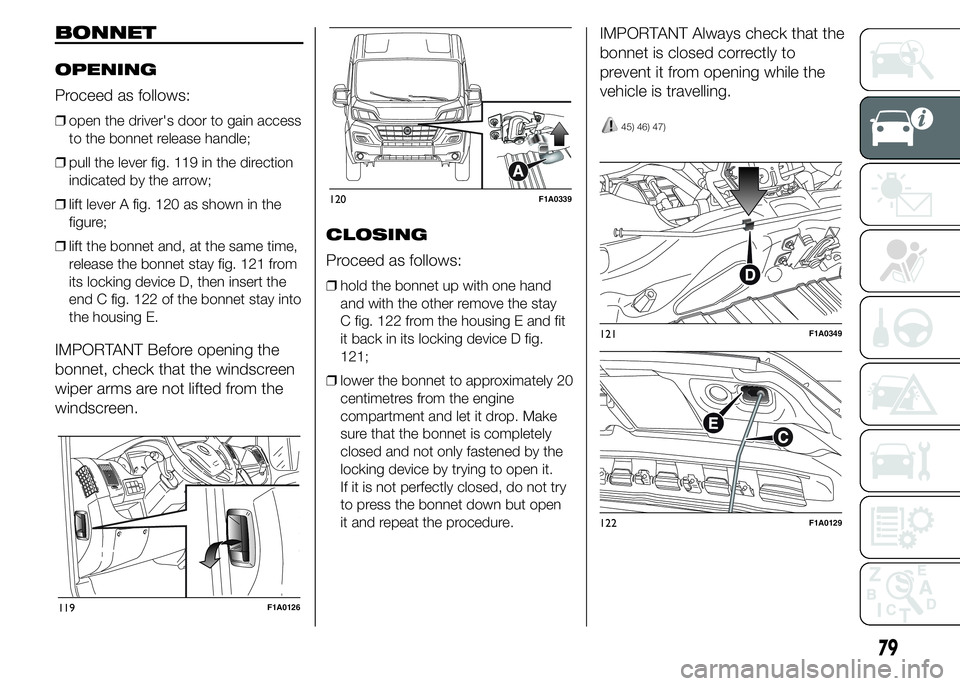
BONNET
OPENING
Proceed as follows:
❒open the driver's door to gain access
to the bonnet release handle;
❒pull the lever fig. 119 in the direction
indicated by the arrow;
❒lift lever A fig. 120 as shown in the
figure;
❒lift the bonnet and, at the same time,
release the bonnet stay fig. 121 from
its locking device D, then insert the
end C fig. 122 of the bonnet stay into
the housing E.
IMPORTANT Before opening the
bonnet, check that the windscreen
wiper arms are not lifted from the
windscreen.CLOSING
Proceed as follows:
❒hold the bonnet up with one hand
and with the other remove the stay
C fig. 122 from the housing E and fit
it back in its locking device D fig.
121;
❒lower the bonnet to approximately 20
centimetres from the engine
compartment and let it drop. Make
sure that the bonnet is completely
closed and not only fastened by the
locking device by trying to open it.
If it is not perfectly closed, do not try
to press the bonnet down but open
it and repeat the procedure.
IMPORTANT Always check that the
bonnet is closed correctly to
prevent it from opening while the
vehicle is travelling.
45) 46) 47)
119F1A0126
120F1A0339
121F1A0349
122F1A0129
79
Page 86 of 367
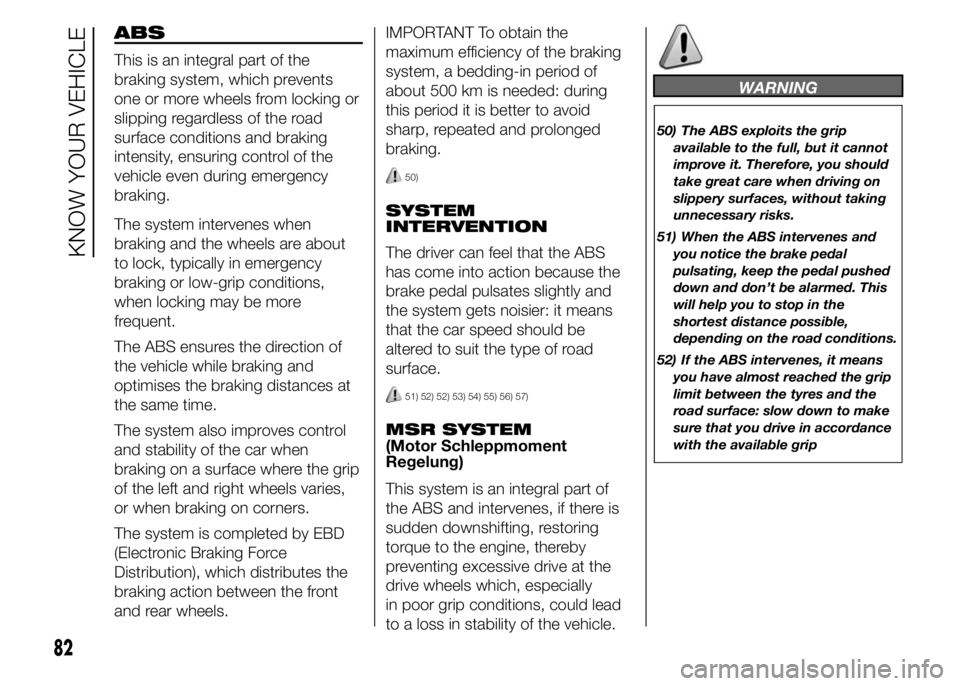
ABS
This is an integral part of the
braking system, which prevents
one or more wheels from locking or
slipping regardless of the road
surface conditions and braking
intensity, ensuring control of the
vehicle even during emergency
braking.
The system intervenes when
braking and the wheels are about
to lock, typically in emergency
braking or low-grip conditions,
when locking may be more
frequent.
The ABS ensures the direction of
the vehicle while braking and
optimises the braking distances at
the same time.
The system also improves control
and stability of the car when
braking on a surface where the grip
of the left and right wheels varies,
or when braking on corners.
The system is completed by EBD
(Electronic Braking Force
Distribution), which distributes the
braking action between the front
and rear wheels.IMPORTANT To obtain the
maximum efficiency of the braking
system, a bedding-in period of
about 500 km is needed: during
this period it is better to avoid
sharp, repeated and prolonged
braking.
50)
SYSTEM
INTERVENTION
The driver can feel that the ABS
has come into action because the
brake pedal pulsates slightly and
the system gets noisier: it means
that the car speed should be
altered to suit the type of road
surface.
51) 52) 52) 53) 54) 55) 56) 57)
MSR SYSTEM
(Motor Schleppmoment
Regelung)
This system is an integral part of
the ABS and intervenes, if there is
sudden downshifting, restoring
torque to the engine, thereby
preventing excessive drive at the
drive wheels which, especially
in poor grip conditions, could lead
to a loss in stability of the vehicle.
WARNING
50) The ABS exploits the grip
available to the full, but it cannot
improve it. Therefore, you should
take great care when driving on
slippery surfaces, without taking
unnecessary risks.
51) When the ABS intervenes and
you notice the brake pedal
pulsating, keep the pedal pushed
down and don’t be alarmed. This
will help you to stop in the
shortest distance possible,
depending on the road conditions.
52) If the ABS intervenes, it means
you have almost reached the grip
limit between the tyres and the
road surface: slow down to make
sure that you drive in accordance
with the available grip
82
KNOW YOUR VEHICLE
Page 87 of 367
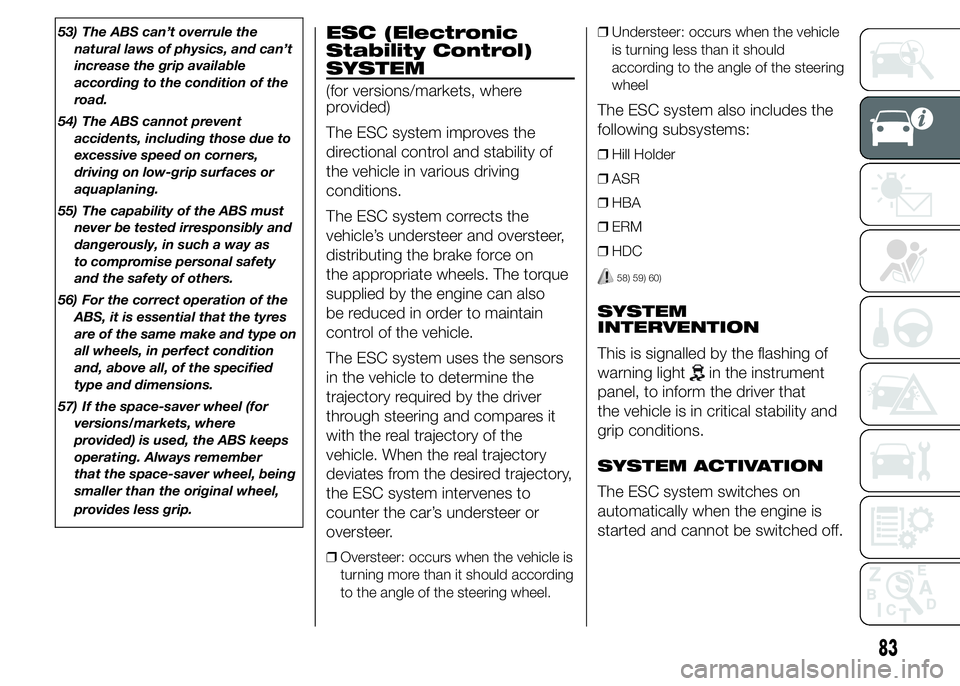
53) The ABS can’t overrule the
natural laws of physics, and can’t
increase the grip available
according to the condition of the
road.
54) The ABS cannot prevent
accidents, including those due to
excessive speed on corners,
driving on low-grip surfaces or
aquaplaning.
55) The capability of the ABS must
never be tested irresponsibly and
dangerously, in such a way as
to compromise personal safety
and the safety of others.
56) For the correct operation of the
ABS, it is essential that the tyres
are of the same make and type on
all wheels, in perfect condition
and, above all, of the specified
type and dimensions.
57) If the space-saver wheel (for
versions/markets, where
provided) is used, the ABS keeps
operating. Always remember
that the space-saver wheel, being
smaller than the original wheel,
provides less grip.ESC (Electronic
Stability Control)
SYSTEM
(for versions/markets, where
provided)
The ESC system improves the
directional control and stability of
the vehicle in various driving
conditions.
The ESC system corrects the
vehicle’s understeer and oversteer,
distributing the brake force on
the appropriate wheels. The torque
supplied by the engine can also
be reduced in order to maintain
control of the vehicle.
The ESC system uses the sensors
in the vehicle to determine the
trajectory required by the driver
through steering and compares it
with the real trajectory of the
vehicle. When the real trajectory
deviates from the desired trajectory,
the ESC system intervenes to
counter the car’s understeer or
oversteer.
❒Oversteer: occurs when the vehicle is
turning more than it should according
to the angle of the steering wheel.❒Understeer: occurs when the vehicle
is turning less than it should
according to the angle of the steering
wheel
The ESC system also includes the
following subsystems:
❒Hill Holder
❒ASR
❒HBA
❒ERM
❒HDC
58) 59) 60)
SYSTEM
INTERVENTION
This is signalled by the flashing of
warning light
in the instrument
panel, to inform the driver that
the vehicle is in critical stability and
grip conditions.
SYSTEM ACTIVATION
The ESC system switches on
automatically when the engine is
started and cannot be switched off.
83
Page 88 of 367
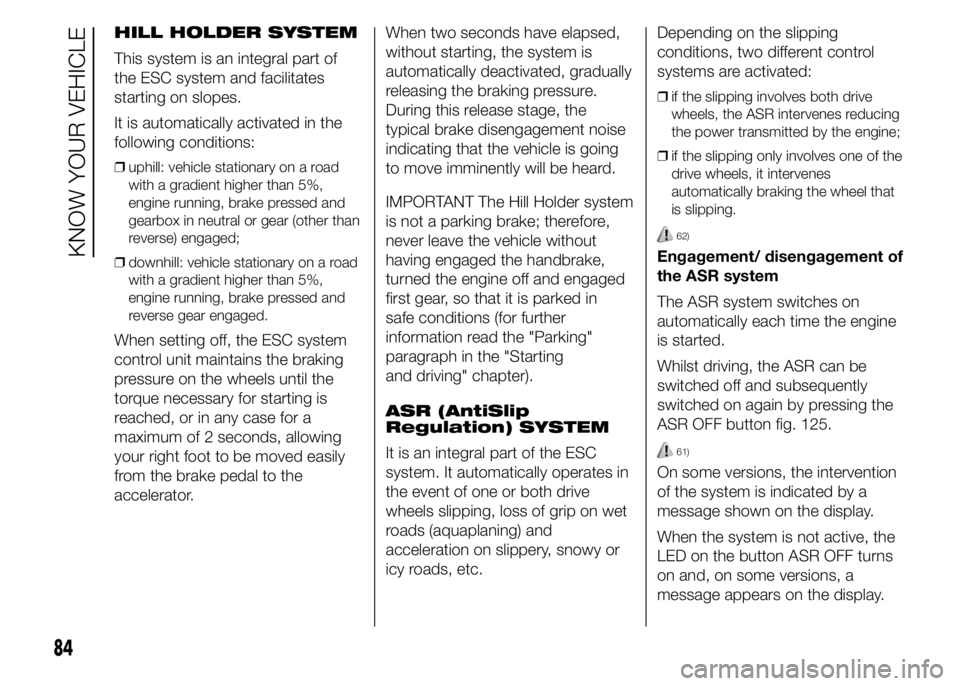
HILL HOLDER SYSTEM
This system is an integral part of
the ESC system and facilitates
starting on slopes.
It is automatically activated in the
following conditions:
❒uphill: vehicle stationary on a road
with a gradient higher than 5%,
engine running, brake pressed and
gearbox in neutral or gear (other than
reverse) engaged;
❒downhill: vehicle stationary on a road
with a gradient higher than 5%,
engine running, brake pressed and
reverse gear engaged.
When setting off, the ESC system
control unit maintains the braking
pressure on the wheels until the
torque necessary for starting is
reached, or in any case for a
maximum of 2 seconds, allowing
your right foot to be moved easily
from the brake pedal to the
accelerator.When two seconds have elapsed,
without starting, the system is
automatically deactivated, gradually
releasing the braking pressure.
During this release stage, the
typical brake disengagement noise
indicating that the vehicle is going
to move imminently will be heard.
IMPORTANT The Hill Holder system
is not a parking brake; therefore,
never leave the vehicle without
having engaged the handbrake,
turned the engine off and engaged
first gear, so that it is parked in
safe conditions (for further
information read the "Parking"
paragraph in the "Starting
and driving" chapter).
ASR (AntiSlip
Regulation) SYSTEM
It is an integral part of the ESC
system. It automatically operates in
the event of one or both drive
wheels slipping, loss of grip on wet
roads (aquaplaning) and
acceleration on slippery, snowy or
icy roads, etc.Depending on the slipping
conditions, two different control
systems are activated:
❒if the slipping involves both drive
wheels, the ASR intervenes reducing
the power transmitted by the engine;
❒if the slipping only involves one of the
drive wheels, it intervenes
automatically braking the wheel that
is slipping.
62)
Engagement/ disengagement of
the ASR system
The ASR system switches on
automatically each time the engine
is started.
Whilst driving, the ASR can be
switched off and subsequently
switched on again by pressing the
ASR OFF button fig. 125.
61)
On some versions, the intervention
of the system is indicated by a
message shown on the display.
When the system is not active, the
LED on the button ASR OFF turns
on and, on some versions, a
message appears on the display.
84
KNOW YOUR VEHICLE
Page 89 of 367
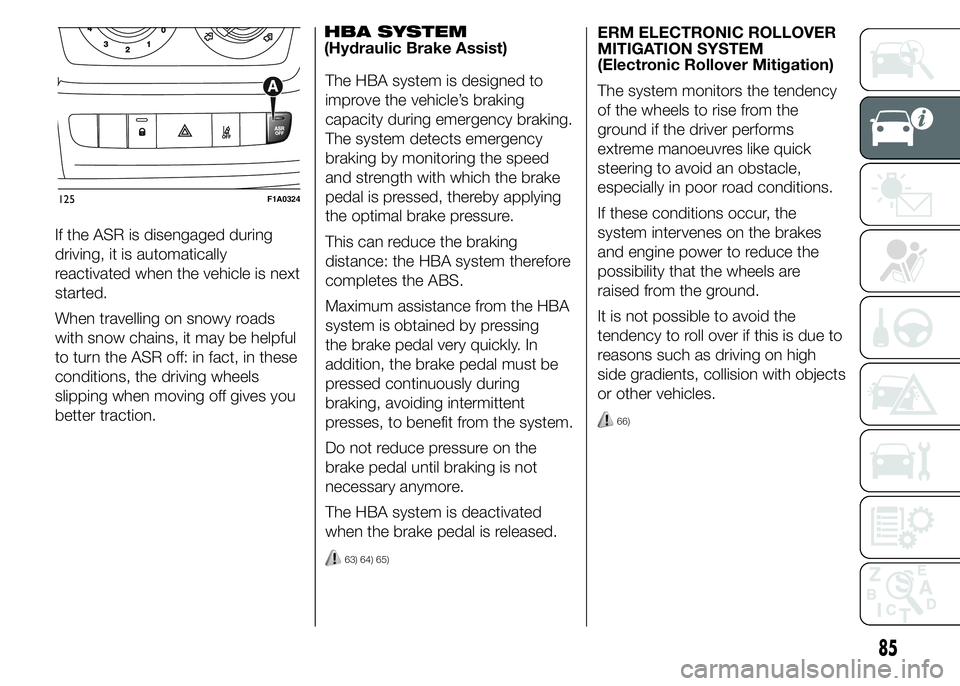
If the ASR is disengaged during
driving, it is automatically
reactivated when the vehicle is next
started.
When travelling on snowy roads
with snow chains, it may be helpful
to turn the ASR off: in fact, in these
conditions, the driving wheels
slipping when moving off gives you
better traction.HBA SYSTEM
(Hydraulic Brake Assist)
The HBA system is designed to
improve the vehicle’s braking
capacity during emergency braking.
The system detects emergency
braking by monitoring the speed
and strength with which the brake
pedal is pressed, thereby applying
the optimal brake pressure.
This can reduce the braking
distance: the HBA system therefore
completes the ABS.
Maximum assistance from the HBA
system is obtained by pressing
the brake pedal very quickly. In
addition, the brake pedal must be
pressed continuously during
braking, avoiding intermittent
presses, to benefit from the system.
Do not reduce pressure on the
brake pedal until braking is not
necessary anymore.
The HBA system is deactivated
when the brake pedal is released.
63) 64) 65)
ERM ELECTRONIC ROLLOVER
MITIGATION SYSTEM
(Electronic Rollover Mitigation)
The system monitors the tendency
of the wheels to rise from the
ground if the driver performs
extreme manoeuvres like quick
steering to avoid an obstacle,
especially in poor road conditions.
If these conditions occur, the
system intervenes on the brakes
and engine power to reduce the
possibility that the wheels are
raised from the ground.
It is not possible to avoid the
tendency to roll over if this is due to
reasons such as driving on high
side gradients, collision with objects
or other vehicles.
66)
125F1A0324
85
Page 90 of 367
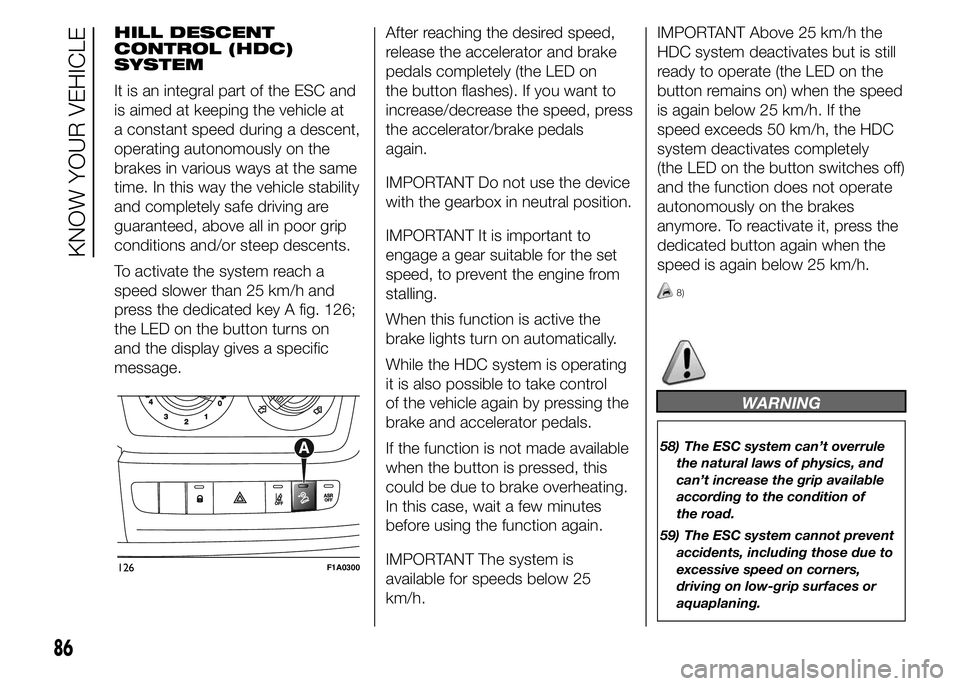
HILL DESCENT
CONTROL (HDC)
SYSTEM
It is an integral part of the ESC and
is aimed at keeping the vehicle at
a constant speed during a descent,
operating autonomously on the
brakes in various ways at the same
time. In this way the vehicle stability
and completely safe driving are
guaranteed, above all in poor grip
conditions and/or steep descents.
To activate the system reach a
speed slower than 25 km/h and
press the dedicated key A fig. 126;
the LED on the button turns on
and the display gives a specific
message.After reaching the desired speed,
release the accelerator and brake
pedals completely (the LED on
the button flashes). If you want to
increase/decrease the speed, press
the accelerator/brake pedals
again.
IMPORTANT Do not use the device
with the gearbox in neutral position.
IMPORTANT It is important to
engage a gear suitable for the set
speed, to prevent the engine from
stalling.
When this function is active the
brake lights turn on automatically.
While the HDC system is operating
it is also possible to take control
of the vehicle again by pressing the
brake and accelerator pedals.
If the function is not made available
when the button is pressed, this
could be due to brake overheating.
In this case, wait a few minutes
before using the function again.
IMPORTANT The system is
available for speeds below 25
km/h.IMPORTANT Above 25 km/h the
HDC system deactivates but is still
ready to operate (the LED on the
button remains on) when the speed
is again below 25 km/h. If the
speed exceeds 50 km/h, the HDC
system deactivates completely
(the LED on the button switches off)
and the function does not operate
autonomously on the brakes
anymore. To reactivate it, press the
dedicated button again when the
speed is again below 25 km/h.
8)
WARNING
58) The ESC system can’t overrule
the natural laws of physics, and
can’t increase the grip available
according to the condition of
the road.
59) The ESC system cannot prevent
accidents, including those due to
excessive speed on corners,
driving on low-grip surfaces or
aquaplaning.
126F1A0300
86
KNOW YOUR VEHICLE
Page 92 of 367
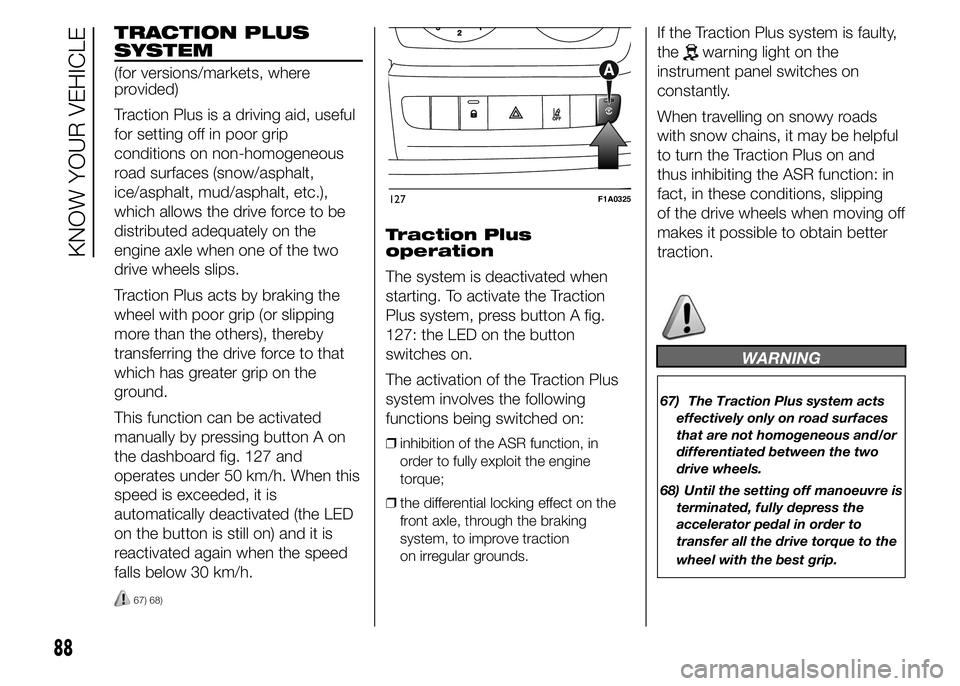
TRACTION PLUS
SYSTEM
(for versions/markets, where
provided)
Traction Plus is a driving aid, useful
for setting off in poor grip
conditions on non-homogeneous
road surfaces (snow/asphalt,
ice/asphalt, mud/asphalt, etc.),
which allows the drive force to be
distributed adequately on the
engine axle when one of the two
drive wheels slips.
Traction Plus acts by braking the
wheel with poor grip (or slipping
more than the others), thereby
transferring the drive force to that
which has greater grip on the
ground.
This function can be activated
manually by pressing button A on
the dashboard fig. 127 and
operates under 50 km/h. When this
speed is exceeded, it is
automatically deactivated (the LED
on the button is still on) and it is
reactivated again when the speed
falls below 30 km/h.
67) 68)
Traction Plus
operation
The system is deactivated when
starting. To activate the Traction
Plus system, press button A fig.
127: the LED on the button
switches on.
The activation of the Traction Plus
system involves the following
functions being switched on:
❒inhibition of the ASR function, in
order to fully exploit the engine
torque;
❒the differential locking effect on the
front axle, through the braking
system, to improve traction
on irregular grounds.
If the Traction Plus system is faulty,
the
warning light on the
instrument panel switches on
constantly.
When travelling on snowy roads
with snow chains, it may be helpful
to turn the Traction Plus on and
thus inhibiting the ASR function: in
fact, in these conditions, slipping
of the drive wheels when moving off
makes it possible to obtain better
traction.
WARNING
67) The Traction Plus system acts
effectively only on road surfaces
that are not homogeneous and/or
differentiated between the two
drive wheels.
68) Until the setting off manoeuvre is
terminated, fully depress the
accelerator pedal in order to
transfer all the drive torque to the
wheel with the best grip.
127F1A0325
88
KNOW YOUR VEHICLE